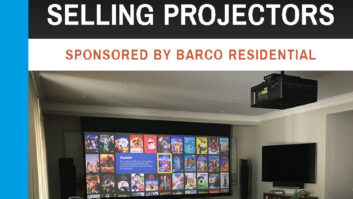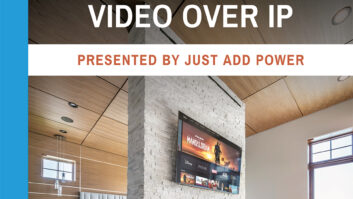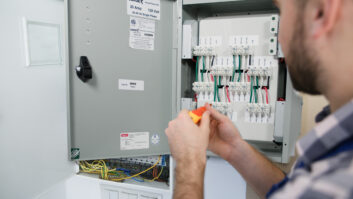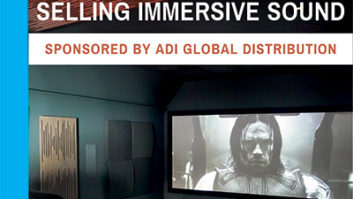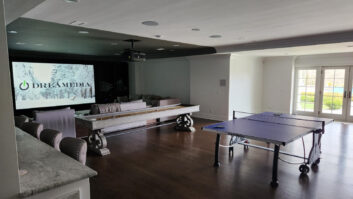The latest generation of projectors offers better picture quality with a host of convenience features, so, to sell clients on them, presentation is everything.
“For basic small theaters, our customers always request a reasonably bright projector that is feature-rich at a fair price,” says Chuck Collins, VP of sales, Digital Projection International. “We typically recommend our E-Vision 4000 4K UHD. It is 3300 lumens and looks fantastic, especially in HDR mode.
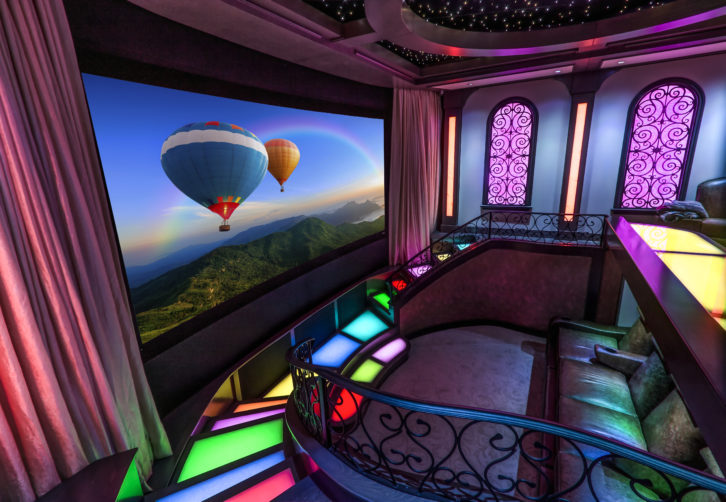
“We haven’t been seeing requests for as many media rooms where projectors will be used with lights on or off, but when we do get a request, we recommend our 10,500-lumen E-Vision 11000 4K projector,” he adds. “It’s great for areas with some modest ambient light. Both of these units are 1-chip models.”
Thankfully, Collins notes, there is finally increased interest in “true” theaters, with more being spec’d. “We think our Satellite Modular Laser System (S-MLS) is a great option for our residential customers who want that next-level experience beyond the conventional projectors that Digital Projection and others build. The S-MLS employs direct red, green, and blue lasers that provide amazing image quality. It is the smallest, lightest, and quietest direct-laser-illuminated 3-chip projection solution on the market today.”
Projector Versus TV
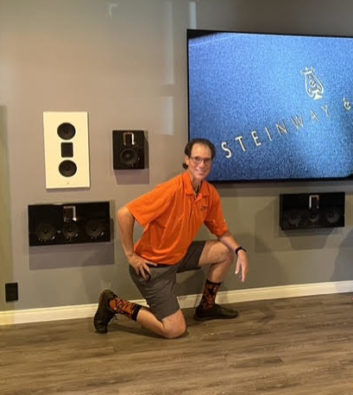
At Atlantic Home Entertainment and Stereo, Tom Farinola, visionary/president and a longtime Sony dealer, says his customers “want a compact-sized projector that hangs from the ceiling with little to no fan noise, high light output to counterbalance when watching it with lights on, and a quick turn on, similar to turning on a TV. Currently, we are selling a lot of the Sony VPL-XW7000 projectors, at $27,999 and the VPL-VW5000 at $45,000.”
“The real question we should ask ourselves is this: What are the advantages of a front projector over a $15,000, 100-inch 4K TV?” he says. “If you like to watch movies on streaming services, Blu-ray discs, or Kaleidescape, then you are aware of the annoying ‘black bars’ that crop your TV. A Sony front projector from medium- to high-end models has Picture Position Memory to eliminate the black bars, provided you have an Anamorphic screen. This will re-create a true cinematic experience that a large TV cannot provide. And if the viewer is a sports enthusiast, the desire is to view a larger than 100-inch image, which can easily be accomplished with a medium-quality front projector.”
Related: 6 Home Projection Trends
Normally, positioning the TV image in a family room is very difficult because the fireplace is typically in the middle of the room, forcing the conventional flat panel to be placed too high, over the fireplace mantle, or to the side of the fireplace. “With a qualified AV specialist, a drop-down projection screen can be installed to drop down over the fireplace, providing the optimum viewing angle,” says Farinola. “This can only be accomplished with a front projector. And mounting a 100-inch TV over the fireplace is typically a daunting task and aesthetically unacceptable, thus making the front projector and a drop-down screen a desirable solution.”
Quiet and Easy
“Typically, people want a projector that displays an incredible picture, but they don’t want to see or hear the projector itself,” says Collins. “Our Satellite Modular Laser System solves that problem. Because the system is literally modular, it allows for the projector head to be separated from the light source by over 300 feet through a proprietary fiber-optic cable. Our HIGHlite Reference projector head is a very small unit easily hidden for in-room use. It is around 13 inches square, weighs only 44 pounds, and is also ‘whisper quiet’ and works off of a 120V circuit.”
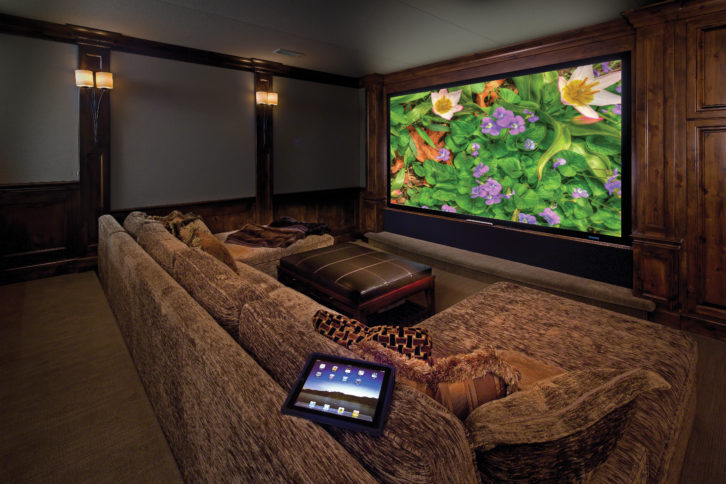
The 9000-lumen illumination module can be installed in a completely different room, separated from the head by just a few feet to hundreds of feet away. “The laser module takes up only four rack units and again uses direct red, green, and blue lasers that provide a very saturated image with a wide color gamut that will satisfy 97 percent of REC2020,” adds Collins.
Hands down, the best approach for selling residential customers on the benefits of installing a projector in their theater is to actually demonstrate the projector, Collins says. “Like it or not, a projector’s image must be seen to be believed. At DPI, we offer a great discount for dealers that invest in a demo unit. And we work closely with our partners to have ready access to our products. It’s also important to present different options to potential buyers who may or may not know what they want yet.”
Always be sure to thoroughly discuss the client’s needs and expectations, Farinola advises. “Remember that the end user is longing for a more immersive experience, not only visually, but audibly. And they desire to have that with products that are easy to use.”
Case Study: Staying Power
A dramatic room transformation often calls for an AV update; when a room is stripped down to the studs, how could you not install a bigger projection screen with an upgraded projector? Although granted an amazing opportunity to upsell their client, the integrators at Elite Audio Video in McKinney, Texas, elected to stand by the tried-and-true Slate screen from Screen Innovations that previously served the room so well, as well as his existing JVC projector. “Neither the owner nor our team saw any reason to replace them. He was extremely happy with the size and imaging from day one, so we kept it,” explains the owner of Elite Audio Video, Justin Dohman.
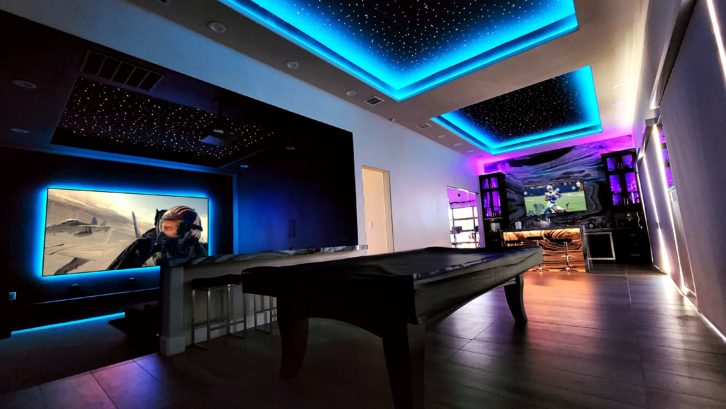
Plus, the Elite Audio Video team needed to focus on other aspects of the remodel: the entire room would be reconstructed and redesigned, adding significant square footage to the existing footprint. “The owner wanted a more open, spacious feel, with a new bar area, complemented by a 75-inch Sony display, and a third panel of fiber optic stars added to the ceiling,” says Dohman. “What he didn’t want to change is the screen or the projector! It stood the test of time; it would also stand up to all the extra LED lighting we installed during the renovation.”
Elite Audio Video had the unique opportunity to do the same job twice, yet thanks to their “future-proof” approach to AV, most of the original equipment passed muster for the second iteration of this contemporary, cutting-edge media room. Natural sunlight and color-changing RGB lighting dominate the space per the owners’ request, making Slate’s Ambient Light Rejecting (ALR) properties and high gain, a huge benefit. The Slate material is so effective at rejecting light, Elite Audio Video was able to deliver an extra visual punch by framing the screen with LED tape lighting. The owner can alter the hue on a whim from a Control4 Neeo remote, while the projected image stays sharp and crisp. The screen’s acoustical transparency further suited the owner’s sense of style. The Origin Acoustics speakers easily tucked in the wall behind the screen material, maintaining a clean, modern aesthetic and making the on-screen action totally immersive.
The screen and JVC projector spring to life at the tap of a button of the Neeo remote, while the lights adjust to the entertainment du jour. No matter what the JVC projector throws at the screen or how brightly the room lights shine, SI’s Slate acoustically transparent, Ambient Light Rejecting screen delivers an outstanding entertainment experience — for the second time around.
